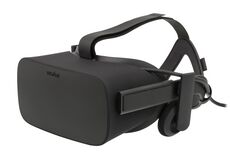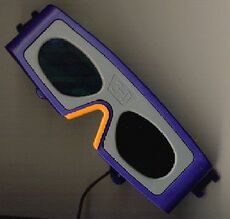Headset
A headset is a head-mounted gadget that can display visuals to the user. It has a display and 3D tracking for updating the contents of the display.
Headsets have been called many things, including VR headsets, AR headsets, and MR headsets.
Some headsets like the Google Glass only have a small display over one eye that is partially transparent.
Eye relief is distance to the eye. For example, a display with eye relief of 12mm means it is 12mm away from the eye.
Building[edit]
To build a headset, the following are required:
- display source such as an LCD
- optional optics such as lenses
- optional driver electronics
- physical housing
- optional 6DOF tracking sensor or SLAM system
Housing[edit]
A housing can be 3D printed.
Screws and fasteners can be bought from McMaster-Carr.
Facial comfort has traditionally been done with foam.
For comfort, a halo headband style is recommended, where the headset primarily rests on the forehead and the back of the head. The forehead part should be curved and at a 45 degree angle upwards in the "nodding" axis.
Cloth is an option for padding.
Types[edit]
A Two-view gadget viewer, AKA a stereoscope, is a simple kind of headset. These gadgets rely on the inserted smartphones to do all of the leg work. It does not need to have any electronics in it, and instead can generally rely on the inserted gadget's electronics.
A Discrete HMD contains a display and some electronics for tracking and other functions. While they are more advanced than the viewers, Discrete HMDs still require connections to PCs for processing.
A head-worn computer has everything needed for VR or AR within the HMD.
Viewers[edit]
Slide-on HMD, also known as Smartphone mount, is the cheapest and most accessible form of VR. The Slide-on consists of a smartphone holder, lenses and some form of basic input. A smartphone is inserted into the HMD and the entire gadget is played upon the eyes of the user to create the VR experience. The Slide-on utilizes the smartphone for display, processing and rotational tracking. Some Slide-on HMDs such as the Gear VR use their own built-in IMUs instead of relying on that of the smartphones.
Popular Slide-on HMDs:
Tethered headset[edit]
A tethered headset has display, lenses, rotational tracking, optionally positional tracking, and optionally speaker output. It is connected to a computer using cables.
Examples:
Head-worn computers[edit]
A standalone HMD, also known as an Integrated HMD, is the most sophisticated and expensive type of HMD. This independent computing gadget is able to deliver VR and/or AR experiences without any external hardware such as PC or smartphone. It contains everything from display to processors to camera and is able to display stereoscopic 3D images, perform complex tracking and utilize advanced input methods. Examples are the Meta Quest Pro and the Meta Quest 3.
Shutterglasses[edit]
Shutterglasses are glasses used for stereoscopic two-view imagery. They can be used in two-view display systems.
The Nuvision 3D-SPEX is a shutterglasses system. It uses a parallel port on a computer.[1]
3D tracking[edit]
3D tracking for a headset needs to be extremely stable.

